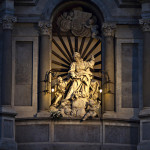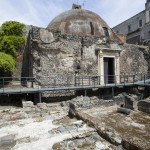The heart of Catania
- 1:30 h
- 260 m
- Easy
You’re in Piazza Duomo, the heart of Catania. At the center stand the symbol of the city, the Elephant or Liotru, and on the left there is the City Hall (UNESCO heritage).
On the right, instead, you could admire Chierici Palace, Amenano fountain and the Cathedral (UNESCO heritage) and the Diocesan Museum. Crossing the arch (Porta Uzeda), on the right visit Pescheria, the traditional market, then walk down via Bottino and reach Piazza Currò and Rotonda’s Thermae.
Elephant’s fountain
The Elephant’s fountain or even “Liotru’s fountain” was built by Gianbattista Vaccarini in 1757. In the basement there are some carved cherubs and two bas-reliefs representing the city’s two rivers, the Simeto and the Amenano. For people of Catania it is ‘u Liotru’.
Palazzo degli Elefanti
Palazzo degli Elefanti, originally was called the Senatorial Palace, it is located on the northern side of Piazza Duomo and it’s the headquarters of the Municipality of Catania. It was built by Vaccarini to replace the medieval Loggia, which was destroyed by the earthquake in 1693.
Are you visiting Catania in February? Admire the parade of Senato's carriages.
Palazzo dei Chierici
The Palazzo dei Chierici, also is known as the Clerks’ Seminary (which once housed it), it’s connected to the Saint Aghata’s Cathedral through an overpass that goes over Uzeda’s entrance. The inclution of building inside the city walls is its hallmark.
Amenano’s fountain
In front of the Elephants’ Palace, the Town Hall, on the south side of Piazza Duomo you can see the Amenano’s fountain, its name derives from the Amenano river that flows underground. People of Catania call this marble fountain: ‘acqua o’ linzolu’.
Saint Agatha’s Cathedral (Duomo)
Saint Agatha’s Cathedral takes its name from the “Santuzza” protector of the city, her feast day is on February 5th. With its massive structure, the Cathedral has the characteristic contrast between the gray and white marble it’s used for the decorations.
Diocesan Museum
The Diocesan Museum is located in the east ala of the Clerics’ seminary next to the Cathedral, preserves Diocese of Catania’s collection of liturgical furnishings. By type, furniture and objects are stored inside dating from several historical periods ranging from 1300 onwards.
Worth a visit the panoramic balcony.
Uzeda gate (porta Uzeda)
Uzeda gate connects the two parts of the old Clerks’ seminary, it was built in 1695 by the Duke of Camastra and was dedicated to the Viceroy Paceco Uzeda. It’s considered a symbol of the city and it is built in typical Catania baroque style: lava stone and white marble.
The Pescheria
The “Pescheria” (Piscaria in Sicilian language) is the old fish market in Catania, which still retains and preserves the ancient folklore. Among the oldest monuments of the city, it extends the fish market. So many people crowd it all day.
To be visited for diving into the folklore of Catania.
Rotonda’s Thermae
The thermal building called “Rotonda’s one” is located in one of the most characteristic areas of Catania. It’s surrounded by a series of streets and alleys in the oldest part of town. The thermae survived to the terrible earthquake in 1693 and for this reason scholars have long considered them the example of building skill.








